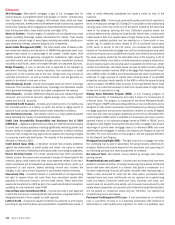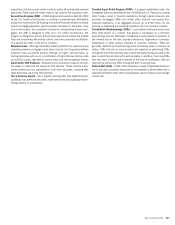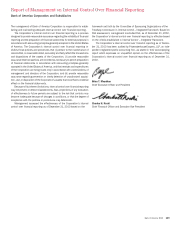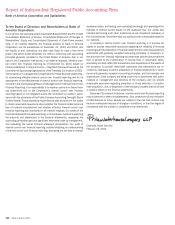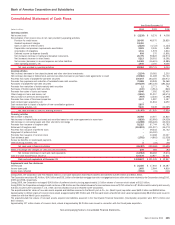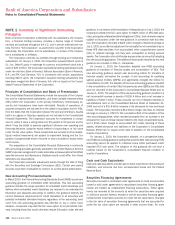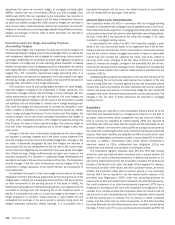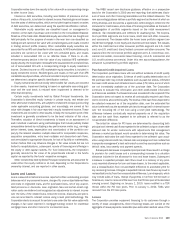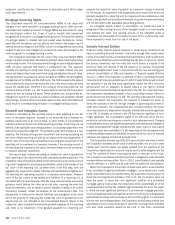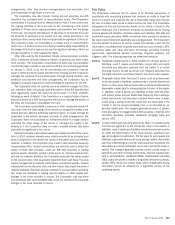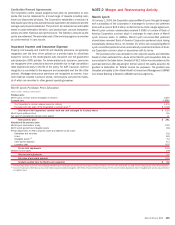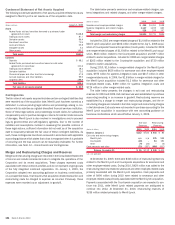Bank of America 2010 Annual Report Download - page 148
Download and view the complete annual report
Please find page 148 of the 2010 Bank of America annual report below. You can navigate through the pages in the report by either clicking on the pages listed below, or by using the keyword search tool below to find specific information within the annual report.Bank of America Corporation and Subsidiaries
Notes to Consolidated Financial Statements
NOTE 1 Summary of Significant Accounting
Principles
Bank of America Corporation (collectively with its subsidiaries, the Corpora-
tion), a financial holding company, provides a diverse range of financial
services and products throughout the U.S. and in certain international mar-
kets. The term “the Corporation” as used herein may refer to the Corporation
individually, the Corporation and its subsidiaries, or certain of the Corpora-
tion’s subsidiaries or affiliates.
The Corporation conducts its activities through banking and nonbanking
subsidiaries. On January 1, 2009, the Corporation acquired Merrill Lynch &
Co., Inc. (Merrill Lynch) in exchange for common and preferred stock with a
value of $29.1 billion. The Corporation operates its banking activities primarily
under two charters: Bank of America, National Association (Bank of America,
N.A.) and FIA Card Services, N.A. In connection with certain acquisitions
including Merrill Lynch, the Corporation acquired banking subsidiaries that
have been merged into Bank of America, N.A. with no impact on the Consol-
idated Financial Statements of the Corporation.
Principles of Consolidation and Basis of Presentation
The Consolidated Financial Statements include the accounts of the Corpora-
tion and its majority-owned subsidiaries, and those variable interest entities
(VIEs) where the Corporation is the primary beneficiary. Intercompany ac-
counts and transactions have been eliminated. Results of operations of
acquired companies are included from the dates of acquisition and for VIEs,
from the dates that the Corporation became the primary beneficiary. Assets
held in an agency or fiduciary capacity are not included in the Consolidated
Financial Statements. The Corporation accounts for investments in compa-
nies for which it owns a voting interest of 20 percent to 50 percent and for
which it has the ability to exercise significant influence over operating and
financing decisions using the equity method of accounting or at fair value
under the fair value option. These investments are included in other assets.
Equity method investments are subject to impairment testing and the Cor-
poration’s proportionate share of income or loss is included in equity invest-
ment income.
The preparation of the Consolidated Financial Statements in conformity
with accounting principles generally accepted in the United States of America
(GAAP) requires management to make estimates and assumptions that affect
reported amounts and disclosures. Realized results could differ from those
estimates and assumptions.
The Corporation evaluates subsequent events through the date of filing
with the Securities and Exchange Commission (SEC). Certain prior period
amounts have been reclassified to conform to current period presentation.
New Accounting Pronouncements
In March 2010, the Financial Accounting Standards Board (FASB) issued new
accounting guidance on embedded credit derivatives. This new accounting
guidance clarifies the scope exception for embedded credit derivatives and
defines which embedded credit derivatives are required to be evaluated for
bifurcation and separate accounting. In addition, the guidance extends the
current disclosure requirements for credit derivatives to all securities with
potential embedded derivative features regardless of the accounting treat-
ment. This new accounting guidance was effective on July 1, 2010. Upon
adoption, companies may elect the fair value option for any beneficial inter-
ests, including those that would otherwise require bifurcation under the new
guidance. In connection with the adoption of the guidance on July 1, 2010, the
Corporation elected the fair value option for $629 million of AFS debt secu-
rities, principally collateralized debt obligations (CDOs), that otherwise may be
subject to bifurcation under the new guidance. In connection with this elec-
tion, the Corporation recorded a $229 million charge to retained earnings on
July 1, 2010 as an after-tax adjustment to reclassify the net unrealized loss on
these AFS debt securities from accumulated other comprehensive income
(OCI) to retained earnings and they were reclassified to trading account
assets. The Corporation did not bifurcate any securities as a result of adopting
the new accounting guidance. The additional disclosures required by this new
guidance are included in Note 4 – Derivatives.
On January 1, 2010, the Corporation adopted new FASB accounting
guidance on transfers of financial assets and consolidation of VIEs. This
new accounting guidance revised sale accounting criteria for transfers of
financial assets, eliminated the concept of and accounting for qualifying
special purpose entities (QSPEs) and significantly changed the criteria for
consolidation of a VIE. The adoption of this new accounting guidance resulted
in the consolidation of certain VIEs that previously were QSPEs and VIEs that
were not recorded on the Corporation’s Consolidated Balance Sheet prior to
January 1, 2010. The adoption of this new accounting guidance resulted in a
net incremental increase in assets of $100.4 billion and a net increase in
liabilities of $106.7 billion. These amounts are net of retained interests in
securitizations held on the Consolidated Balance Sheet at December 31,
2009 and net of a $10.8 billion increase in the allowance for loan and lease
losses. The Corporation recorded a $6.2 billion charge, net-of-tax, to retained
earnings on January 1, 2010 for the cumulative effect of the adoption of this
new accounting guidance, which resulted principally from an increase in the
allowance for loan and lease losses related to the newly consolidated loans,
and a $116 million charge to accumulated OCI. Initial recording of these
assets, related allowance and liabilities on the Corporation’s Consolidated
Balance Sheet had no impact at the date of adoption on the consolidated
results of operations.
On January 1, 2010, the Corporation adopted, on a prospective basis,
new FASB accounting guidance stating that troubled debt restructuring (TDR)
accounting cannot be applied to individual loans within purchased credit-
impaired (PCI) loan pools. The adoption of this guidance did not have a
material impact on the Corporation’s consolidated financial condition or
results of operations.
Cash and Cash Equivalents
Cash and cash equivalents include cash on hand, cash items in the process of
collection, and amounts due from correspondent banks and the Federal
Reserve Bank.
Securities Financing Agreements
Securities borrowed or purchased under agreements to resell and securities
loaned or sold under agreements to repurchase (securities financing agree-
ments) are treated as collateralized financing transactions. These agree-
ments are recorded at the amounts at which the securities were acquired
or sold plus accrued interest, except for certain securities financing agree-
ments that the Corporation accounts for under the fair value option. Changes
in the fair value of securities financing agreements that are accounted for
under the fair value option are recorded in other income (loss). For more
146 Bank of America 2010


